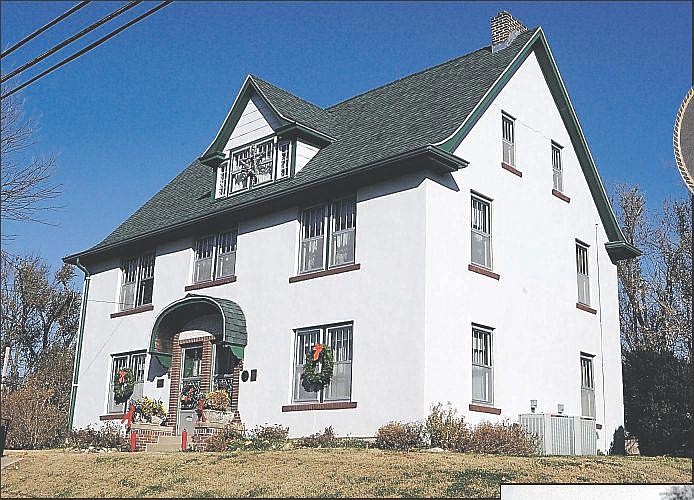History and tradition have been a mainstay at 224 W. Elm St. and for the Schroeder family, because of adaptability and modifications to keep up with the times.
Although today it is the home of the fourth generation from original residents Albert and Wilhelmine Thomas, the shell is the city's oldest remaining structure originally built as a church.
The German Methodist Episcopal Church erected the soft brick house of worship in 1874. The Thomases were members and all but their youngest daughter Edna were confirmed there.
The church's entrance faced Broadway Street at street level. It was a one-story structure with vaulted ceilings.
In 1930, the Thomas family remodeled the shell, which had been vacant since 1916 when the German-speaking congregation disbanded.
When the remodeling was complete, the three-story, stucco-covered duplex faced West Elm Street. And due to the city's grading of the streets, it sat much higher than street level.
The steep-pitched roof was converted to a swoop style. A sunporch was added and a garage was excavated.
"It was a complete remodel," said current owner and great-granddaughter of the Thomases, Julianna Schroeder.
Several pieces of the church remain, including the altar rail now used as the third-floor stair rail, an exterior architecutral ornament, the altar table and companion chairs, a pew, and the bottle-opener-shaped front door key.
Even the sunporch's storm windows were recycled from an old steamboat, Julianna said.
"They were resourceful, pennypinching Germans and they were trying to save money," Julianna said.
The Thomases' plan in the conversion had been for Edna and her new husband, Walter A.F. Schroeder, to live in the second-floor apartment, while Albert and Wilhelmine would move from next door into the first-floor apartment.
But the Great Depression modified that plan too, moving the Thomases in with the Schroeders, who soon had children whose rooms were made in the third-floor. That left the first floor for rental income, often from state employees who walked to work.
The Thomases and the Schroeders were generous and friendly to their renters and their neighbors.
The Thomases, who were German immigrants, settled in the Old Munichburg area in 1888 and lived in three other homes in the 200 block of West Elm Street before their final move.
The Schroeders became fixtures in the tight-knit neighborhood.
That tradition continues as Julianna's father, Walter A. Schroeder, currently serves as the president of the Old Munichburg Association. And the window blinds in the second-floor corner are up again this December to show off another holiday tradition.
While living at 215 W. Elm St., Albert Thomas built the family's Weihnachtspyramide for Christmas 1892.
Built in traditional German fashion, made of scrap lumber and a broom-handle center, the wooden "Christmas pyramid" stands in the same corner window this year as it has for decades before.
"We make a point of turning on the lights by 5 p.m. so people going home from work can see the tree," Julianna said.
However, the five-foot-tall decoration has been updated over time, with the original spinning mechanism converted from candle heat to coal oil heat to an electric fan to the present-day music box motor. And each year a new ornament is placed on the "tree."
"Every square inch of it is decorated," Julianna said.
She contends that the tree has stood the test of time because it is not "German," remaining in its original form, but German-American.
"The tree has adapted and changed; it's not static," Julianna said. "The point of the contraption is to have the Nativity spin around like a parade."
Updating the delicate tree, with some points held together with toothpicks and Elmer's glue, wasn't difficult, Julianna said. She would ask herself what her grandmother would have wanted and that often meant replacing things that were no longer shiny.
The tree still features decorations of fruit, a winter treat in Edna Schroeder's youth. But it has items from today too, like pink flamingos in the interior "garden."
"So much about Christmas is nostalgic," Julianna said. "That's why we have traditions, they tie us to previous generations - this holds memories of people I never knew.
"The "Christmas tree' is not mine; it's the family's. I'm holding onto it for the next genera- tion."
When Edna passed away in 2000, the family didn't want to see the Weihnachtspyramide anywhere but at 224 W. Elm St. And as Julianna walked through the home trying to decide which pieces of her family's past she wanted to take back to her modern apartment, she realized she would rather leave them where they were.
So she and Susan Ferber bought the place and have kept many of the home's feature and family traditions alive.
"We thought it was a real neat house ... with good vibes," Julianna said.
But along with the "Christmas tree" tradition came the annual family sauerbraten and red cabbage celebration and the New Year's Eve legacy.
"This is party central for the Schroeder family," Julianna said. "(Edna) loved getting together as many times as she could. She was quite a hostess and loved to cook."
Julianna and Ferber took up studying German "soul-food" recipes to continue the traditional meals and they still use the tiny kitchen and 1930s stove Julianna's grandmother used.
"You see big kitchens and modern conveniences," Julianna noted. "Then look at this little-bitty kitchen. I thought, "If grandma could pull it off, surely I can too.'
"It's pretty neat to continue."
The strongest tradition of both the Schroeder family and 224 W. Elm St. may be adaptation, blending their German heritage with their American lives.
"We continue these traditions, because they are good traditions to have," Julianna said. "I'm just a link in the chain. I hope the younger generation will continue this."

